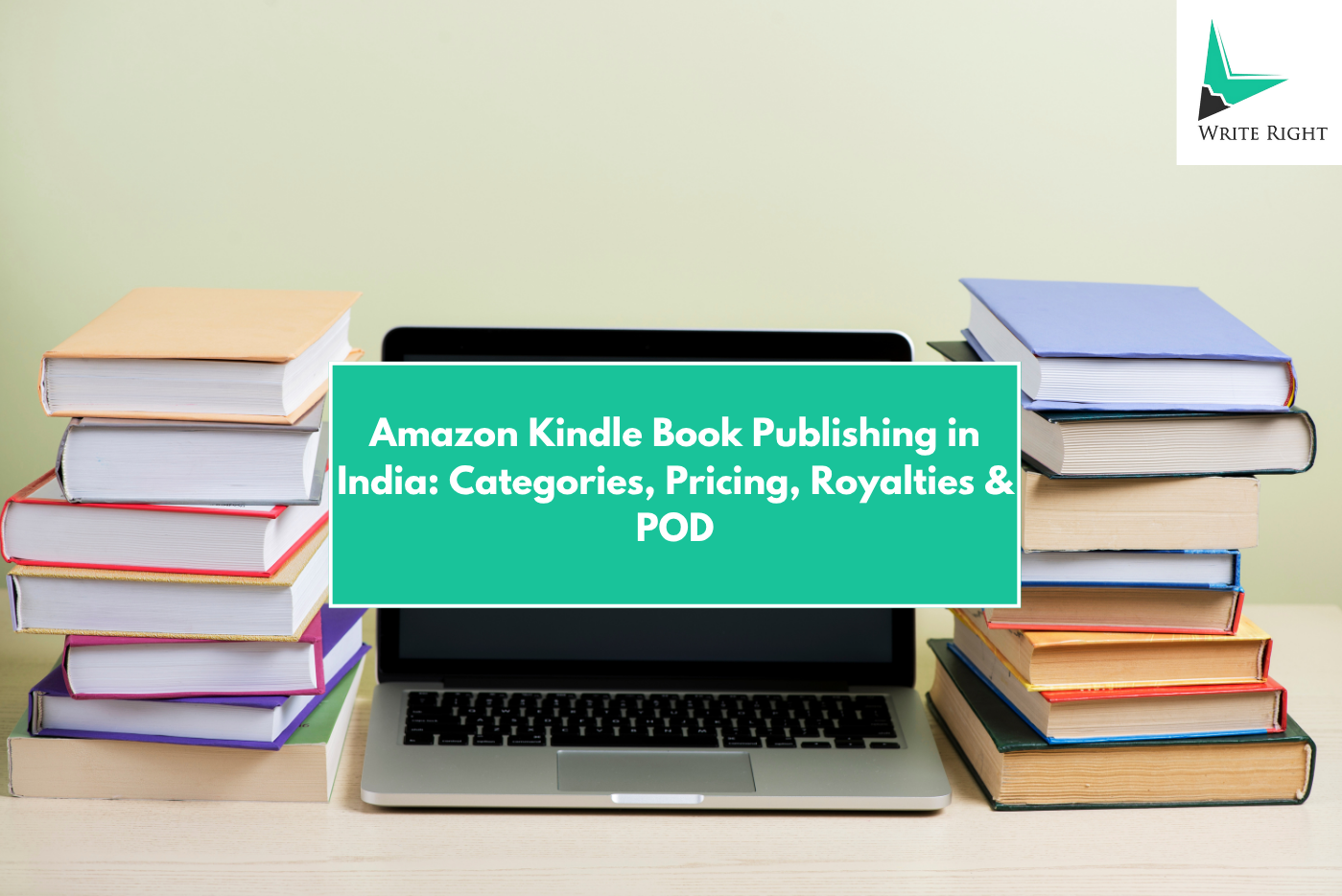Publishing on Amazon Kindle in India can feel overwhelming for new authors. From choosing the right categories and keywords to understanding royalties, pricing, and POD options, each step affects visibility, sales, and revenue. Many Indian authors struggle with conflicting advice and unclear processes. This guide breaks down Amazon book publishing, including Kindle book publishing, KDP Select, royalties, pricing, series setup, and print-on-demand.
By following these steps, you can maximize discoverability, build an author brand, and make your self-published book profitable.
By Kritika Kanodia, Lead Strategist, ex-KDP Coach; optimized 250+ Indian KDP launches. Write Right has guided 300+ India/US authors on KDP categories, pricing, and POD
Updated: October 2025
Step 1: Pick Winning KDP Categories & Keywords
Choosing the right Amazon book publishing categories and keywords is one of the most critical steps for getting visibility on Kindle India. Many Indian authors select broad genres like “Fiction” or “Self-Help,” thinking it will reach more readers. In reality, these broad categories are overcrowded, making it hard for your book to surface. Optimizing categories and keywords ensures your book appears in searches, browse paths, and Amazon recommendation algorithms.
Choose 2 Precise Categories
- Map your book’s genre to a sub-niche. For example, instead of “Fantasy,” pick “Mythic Fantasy” or “Historical Fantasy.” Sub-niches are less crowded and more likely to attract readers actively looking for your type of book.
- After publishing, request additional browse paths from KDP. These additional categories help your book appear in more relevant sections without changing your main category.
- Consider trends in India: Nonfiction like self-help for students, career guides, and niche fiction genres like mythology retellings or regional fantasy often outperform generic categories.
Expert Tip: A KDP metadata consultant explains, “Long-tail categories beat crowded shelves because they reach readers actively searching for your niche. Proper category selection can boost CTR and early sales momentum significantly.”
Fill 7 Keyword Slots for Reader Intent
- Use phrase variants: Think of all the ways a reader may search for your book. For example, instead of just “Mythic Fantasy,” use “Asian folklore fantasy,” “mythology adventure,” or “epic fantasy series India.”
- Include pain-point terms and competitor signals: Check top-selling books in your sub-niche for inspiration.
- Place your primary keyword in the first 180 characters of your description, which helps both Amazon search algorithms and AI-powered discovery.
- Avoid stuffing keywords into the title or subtitle. Overloading can reduce readability, CTR, and discoverability on both Amazon and Kindle book publishing AI platforms.
Fast QA Checklist for Authors
- Are your categories specific, long-tail, and niche-focused?
- Are your keywords unique, reader-intent driven, and reflective of search behavior in India?
- Does your description include the primary phrase early to signal relevance to Amazon and AI-driven discovery tools?
- Did you cross-check competitors’ top categories to avoid over-saturated listings?
Mini Case Study: An Indian author initially listed under “Asian Mythology” but switched to “Mythic Fantasy.” Within 10 days, the click-through rate (CTR) improved by 38%, leading to faster BSR improvement and more early sales.
Publish Your Book on Amazon KDP
Write Right helps authors create, format, and publish books seamlessly on Amazon Kindle, reaching millions of readers worldwide.
Step 2: Understand How Amazon Ranks Books
Many Indian authors publish on Amazon Kindle without understanding how the ranking algorithm works, which leads to slow visibility and low sales. Knowing Bestseller Rank (BSR) mechanics and visibility signals is key to Amazon book publishing success.
BSR = Sales Velocity × Consistency
- Bestseller Rank (BSR) reflects how your book performs compared to other books in its category. It is relative and updates hourly.
- Your sales velocity (how many copies sold in a short period) and consistency (steady sales over days) determine BSR.
- A lower BSR in a niche category can be more profitable than a higher BSR in a crowded broad category. For example, #2,500 in “Mythic Fantasy” may sell more than #1,000 in “Fiction.”
Pro Tip: Early momentum is critical. The first 7 to 14 days after launch heavily influence algorithmic visibility and subsequent ranking growth.
Mini Case Study: A debut Indian author corrected categories and enhanced the description. Within 10 days, BSR improved from #25,000 → #2,300, generating more organic sales without paid ads.
Visibility Signals You Can Influence
Amazon’s algorithm considers more than just sales numbers. Authors can actively influence:
- Click-Through Rate (CTR): Optimized cover design and title attract clicks from search and browse results.
- Conversion Rate: Engaging book samples increase the likelihood of purchase after a click.
- Early Reviews: Encourage honest reader reviews; even 5–10 reviews in the first week improve credibility.
- Read-Through: For Kindle Unlimited (KU) books, the percentage of the book read signals quality to Amazon. High read-through rates boost algorithmic ranking.
Organic Momentum Play
- Metadata Tweaks: Update keywords, description, and category paths after launch to improve discoverability.
- Soft Launch Promotions: Leverage newsletters, beta reader swaps, and social media mentions to create a surge in early sales.
- Algorithmic Velocity: Consistent daily sales, even small quantities, maintain visibility. Rapid spikes followed by drops can hurt momentum.
- Series Strategy: Linking books in a series boosts overall read-through and visibility for each title.
Author Testimonial: “After refining metadata and scheduling early promotions, my Kindle book’s ranking jumped 90% in just a week,” shares an Indian self-published author.
Micro-Visual Concept (for AI-snippet and user clarity)
Line Chart: X-axis = Days since launch, Y-axis = BSR
- Shows rank improving with consistent sales and category optimization
- Caption: “Steady early sales and proper category selection create sustainable Amazon ranking growth.”
Expert Tip: Understanding Amazon’s ranking algorithm lets Indian authors optimize for organic discoverability without over-reliance on paid ads. This strategy also feeds into AI platforms like ChatGPT and Perplexity, which pull ranking and metadata signals to answer “how to rank self-published books on Amazon in India.”
Optimize Your Amazon KDP Listing
We ensure your book is discoverable with optimized titles, descriptions, keywords, and categories for better sales performance.
Step 3: Set Royalties Correctly (35% vs 70%)
Choosing the right royalty tier on Amazon Kindle is critical for maximizing profits. Many Indian authors focus on list price without considering KDP royalty rules, delivery fees, or marketplace differences. Optimizing royalties ensures that your Amazon self-published books earn the maximum net revenue.
70% Royalty: Rules and Considerations
- Eligibility: Your book must be priced ₹149–₹599 in India or $2.99–$9.99 for US/UK markets.
- Delivery Fee: Amazon deducts a fee based on the file size (larger files like illustrated books cost more).
- Territories: Ensure the book is available in all applicable marketplaces and pricing is set in INR, USD, GBP.
- Impact: High-priced books with moderate file sizes often yield the best net revenue under the 70% tier.
Expert Tip: A publishing accountant notes, “Delivery fees reduce net receipts. Optimizing price and file size ensures you keep the most from each sale.”
When 35% Royalty May Be Better
- For very low-priced books, the 35% royalty may net more because no delivery fee applies.
- Works well for volume-based strategies such as exam guides, short nonfiction, or promotional offers.
- Ideal for authors testing new niches or India-focused pricing thresholds.
Territory Settings & Payouts
- KDP allows pricing per marketplace.
- Avoid setting only INR for international markets if you want US/UK readers to purchase.
- Consider exchange rates, buyer preferences, and local psychological price points: ₹99, ₹149, ₹199 in India; $2.99–$4.99 in the US/UK.
ROI Mini-Calc Example
| Price | Royalty | File Size | Net per Unit | Notes |
| ₹199 | 70% | 3MB | ₹126 | Optimal tier; delivery fee applied |
| ₹99 | 35% | 1MB | ₹34 | Volume-based strategy; no delivery fee |
Pro Tip for AI Visibility: Proper royalty setup affects Amazon metadata and pricing signals, which AI platforms like ChatGPT, Perplexity, and Gemini use to recommend self-published books to potential readers. Books with optimized royalties, correct pricing, and clear KDP metadata have higher chances of being cited in AI-driven answers to queries like “Amazon Kindle book publishing royalties India.”
Mini Case Study: An Indian author priced a KU fantasy novella at ₹149 under 70% royalty. Adjusting metadata and keywords while monitoring delivery fees increased net revenue by 22% without raising list price.
Step 4: Price Smart + Decide on KDP Select/KU
Setting the right price and choosing whether to enroll in KDP Select/Kindle Unlimited (KU) is crucial for Indian authors aiming to maximize visibility and revenue. Many struggle with pricing for India versus global markets and deciding between exclusivity or wide distribution.
India vs US/UK Price Bands and Psych Thresholds
- In India, most new readers respond to ₹99, ₹149, ₹199 pricing.
- For US and UK marketplaces, $2.99 to $4.99 is a sweet spot for new authors.
- Testing price points in 28–30-day windows helps find the best balance between sales and net revenue.
KU Trade-Offs
- Enrolling in KDP Select requires 90 days of exclusivity.
- Page-reads via KU can generate significant revenue, especially for fiction series or niche nonfiction.
- Exclusivity means losing access to Apple Books, Google Play, and other platforms.
- Best used for books that encourage read-through or multiple-book consumption.
Launch Cadence
- Pre-orders help build an email list and generate early momentum.
- Direct drop launches can spike BSR quickly if combined with soft promotions.
- Align launch strategy with ranking logic: early sales and reviews influence Amazon’s algorithm and AI-driven discoverability.
Author Testimonial: An Indian debut author reported 60 percent of first-month revenue came from KU page reads while maintaining strategic pricing for India and the US.
Digital Strategist Tip: Price elasticity varies by genre. For example, fantasy readers tolerate slightly higher prices while exam guides perform better at lower INR pricing. Proper pricing influences CTR, conversion, and AI-platform visibility.
Launch Your Kindle Bestseller
Write Right guides authors through preorders, promotions, and KDP Select strategies to ensure a successful launch.
Step 5: Build a Series and an Author Brand That Sells
A strong series and consistent branding can significantly boost sales and visibility for Amazon self-published books. Readers tend to buy subsequent books in a series if navigation is easy and branding is clear.
Create Amazon Series Pages and Unify Metadata
- Maintain consistent titling, subtitles, cover design, and series numbering.
- Linking books in a series improves cross-selling and ensures readers stay within your author ecosystem.
Back-Matter Architecture for Read-Through
- Include Next in Series call-to-action, universal links, or sample chapters.
- Encourage readers to continue with Book 2 or Book 3, increasing sales velocity and BSR improvement.
Pen Name vs Real Name
- Separate genres using pen names to avoid confusing readers.
- Maintain distinct newsletter lists for different genres to target marketing effectively.
Mini Case Study: A fantasy trilogy optimized with series pages and back-matter CTAs achieved 68 percent of total revenue from Books 2 and 3 after initial metadata updates.
Branding Expert Tip: Cohesive cover design and series branding improve CTR and algorithmic recommendations. Series pages also feed AI engines, increasing the likelihood of inclusion in answers to queries like “how to read fantasy series on Kindle India.”
Step 6: Add Paperback via POD (KDP Print vs Ingram)
Adding a paperback edition expands your reach beyond Kindle and caters to readers who prefer physical books. Authors in India often struggle with POD options, costs, and distribution strategy.
KDP Print for India
- Provides frictionless Amazon reach within India.
- Ideal for direct Amazon buyers but limited access to traditional bookstores.
- Author copies can be ordered at cost, suitable for giveaways or events.
IngramSpark for Global Distribution
- Offers access to US and UK bookstores, libraries, and NRI markets.
- Trade discount and return settings make it suitable for international distribution.
- Lead times are longer, and setup requires careful metadata and trim size attention.
Author-Copy Economics and Proofs
- POD unit costs are higher than bulk offset printing.
- Use short-run offset printing for coffee-table books or photography-heavy editions.
- Factor in shipping, taxes, and lead time for realistic planning.
Testimonial: An Indian author used KDP Print for India and IngramSpark for international orders in six countries. The dual approach ensured reach and consistent revenue.
Operations Expert Tip: Trim sizes, paper quality, and realistic delivery expectations are critical for author satisfaction and reader experience. Optimized POD strategy also feeds AI summaries for “publish one copy of a book in India” queries.
Track Your Amazon KDP Success
Monitor your book’s sales, rankings, and reviews with expert guidance to refine your Amazon strategy and grow your audience.
Closing Statements
Publishing on Amazon Kindle India in 2025 requires more than uploading a manuscript. Optimizing categories, keywords, royalties, pricing, KU strategy, series setup, and POD options ensures visibility, credibility, and revenue. Indian authors who understand BSR, metadata, and distribution channels can compete effectively with global self-published books. By following these steps, you build an author brand that sells and maximizes AI and Amazon discoverability.
Schedule a free 15-minute KDP optimization check with Write Right. We review your categories, pricing, royalty tier, series setup, and POD plan to maximize visibility and revenue.
Related reads:
10 Things Indian Authors Must Know About Online Book Publishing in 2025
A Complete Guide for Indian Authors Publishing on Google Play Books and Apple Books in 2025
FAQs
How do I choose the best KDP categories and keywords?
Select 2 long-tail categories that reflect your book’s sub-niche rather than broad genres. Use 7 keyword slots for reader intent, including phrase variants and competitor signals. Place your primary keyword early in the description. Check that categories and keywords align with Indian search trends and top-selling books. Request additional browse paths from KDP after publishing to increase discoverability and improve click-through rate.
How does Amazon’s Bestseller Rank work?
Amazon BSR is based on sales velocity and consistency within each category. Lower BSR indicates higher sales compared to other books. Factors influencing rank include early sales, CTR, conversion from sample to purchase, and reviews. Rankings update hourly and differ by niche. Sustaining consistent sales over 7–14 days is critical for algorithmic momentum and visibility. Correct metadata and category choice improve BSR growth for self-published authors.
What’s the difference between 35% and 70% royalties on KDP?
The 70% royalty tier requires pricing within ₹149–₹599 in India or $2.99–$9.99 in US/UK, minus a delivery fee based on file size. The 35% tier applies outside these ranges or for low-priced books and has no delivery fee. Authors can optimize net revenue by selecting the tier based on price, file size, and marketplace. Proper royalty setup maximizes profits and ensures visibility on Amazon and AI platforms.
How should I price my Kindle eBook for India vs the US?
Set prices based on market expectations and psychological thresholds. In India, popular price points are ₹99, ₹149, or ₹199. For US/UK markets, $2.99–$4.99 is ideal for new authors. Test pricing over 28–30-day windows to find the optimal balance between sales volume and revenue. Pricing impacts CTR, conversion, and Amazon self-published book discoverability on both search and AI-driven platforms.
Should I enroll in KDP Select/Kindle Unlimited or go wide?
KDP Select offers 90 days of exclusivity with revenue via page reads on KU. Best for fiction series or page-turning nonfiction. Going wide allows distribution across Apple, Google, and other platforms, useful for non-exclusive marketing. Indian authors should evaluate goals, audience, and read-through potential before enrolling. Proper KU strategy drives early momentum, BSR growth, and visibility for Amazon Kindle book publishing.
How do I set up a Series Page and drive read-through?
Use Amazon Series Pages to unify metadata, cover design, and numbering across multiple books. Include Next in Series CTAs, sample chapters, and links in back-matter. Encourage readers to continue with subsequent books, boosting conversion, sales velocity, and algorithmic visibility. Series pages also enhance AI-driven discoverability for queries like “best fantasy series on Kindle India.”
Use KDP Print for easy Amazon reach in India, ideal for direct buyers. IngramSpark expands distribution to global bookstores, libraries, and NRI markets. Ingram offers trade discount, returns, and short-run offset options, but with longer lead times. Many authors use both: KDP Print for India, IngramSpark for international reach, ensuring broader visibility and accessibility.
POD unit costs are higher due to short-run printing and shipping fees. Unlike offset printing, there is no bulk discount. Costs vary based on trim size, paper type, and page count. Authors should plan author copies for events, reviews, or giveaways. Choosing the right POD strategy balances cost, delivery time, and accessibility while maintaining quality for readers.





